Set Review ➟ LEGO® 42141 F1 Mclaren Formula 1 Team 2022

After one of the most exciting Formula One seasons ever and with a design update rumoured to be the most impactful in 30+ years, LEGO is right on point with releasing a new F1 car. And not just any car, the most detailed and largest one to date with a length of a whopping 65cm.
The rumours of a F1 car have been buzzing for a while but which one.. After collaborations with Ferrari, Mercedes and McLaren these were the top contenders. Personally I feel McLaren is the ideal choice. A team of drivers that brings smiles to the entire paddock and fans everywhere backed up by one of the most impressive legacies in the paddock. 20 World championships and over 180 race wins and many great names like Senna, Prost, Lauda, Hamilton and Fernando Alonso representing the team.
With the new 2022 car being developed, LEGO faced a big challenge to create the set while the car was not yet finalised. Compared to earlier sets this is most designed to be as close to the real deal as possible. A lot of attention has been given to the bodywork, even adding three brand new LEGO pieces to create the perfect design. We’ll come across them later in the review.
The build is done in 4 phases and in this review I’ll take you through them sharing the high’s and low’s you will come across.
Phase 1
In the first part of the build, you create the rear suspension and gearbox. This set is definitively a TECHNIC set but it’s good to know from the start that this set is not filled with a long feature set. There is a six-cylinder engine, a differential at the rear-axle and a straightforward steering system. No hand-of-God steering, gearbox of other mechanisms. That being said, this set is aimed more at design (and truly succeeding). The setup of the suspension is very interesting though. Modern formula 1 cars have a very stiff suspension and LEGO has created a system that mimics this quite nicely.
Where you would normally find your shock-absorbers alongside the wheelbase, in this set a system has been designed where a rod from the wheel is brought to the shock-absorber at an angle, making it very stiff.

Once this system is built and after building part of the chassis, you build the six-cylinder engine. In 2022, Formula 1 goes to a new engine with six 6 cylinders. Later on in phase 4 we’ll see that this is creatively shown through the bodywork. Although this is a part of the car that is not lifelike at all, it’s done in a subtle way making it less of a controversy. As there are no ways of opening the body work up and seeing the engine one can understand why the choice was made.
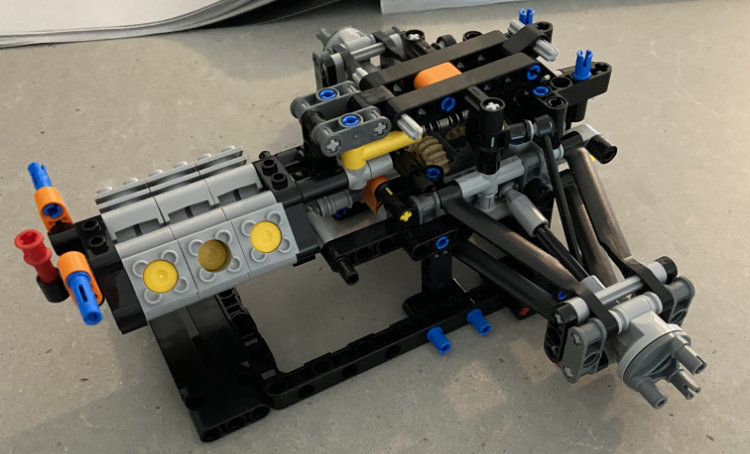
At this point in the build I am quite excited about the suspension solution. When you look at the above image, the wheel can only move up and not down. It will be interesting to see how it feels in the set once it is completely built. It also makes me curious to see how the front- and rear wing will work. In other F1 sets these have been simpler and sometimes too flexible. This set feels sturdy/stiff as you should expect from a modern F1 car.
Phase 2
This phase starts off with building the steering system which is quite straightforward. Next you start building the base for the front wheels and the suspension. Here again the suspension is not next to the wheels but at the same 45 degree angle from the wheelbase as we have seen in the back. This time though the build is a little trickier, as you will find around step 98 in the manual. The build up of the wheelbase and the rods is very lifelike compared to the current F1 cars. Once we have completed building part of the nose connected to the suspension and steering, we find the very first brand new part.
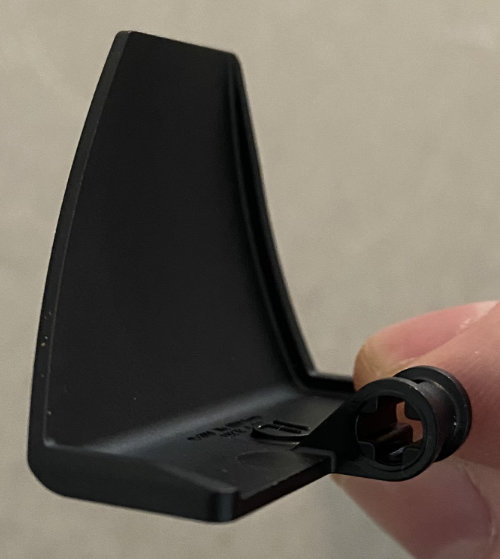
This winged plate is something you will see hovering over the front wheels of all F1 cars in the season 2022. At the end of phase 2 the same part is used to create part of the side of the front wing (wing end-plates in F1 terminology).
Shortly after this is done, we meet another new part! This part has the potential to be used on more sets and is more functional compared to the new wing plate.
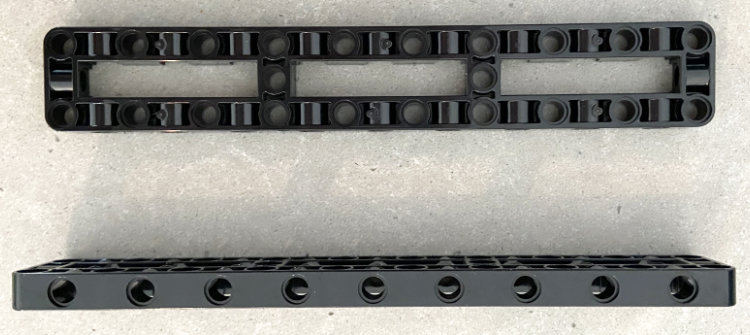
It’s main function in this set is to create a lean build of the body of the car and smoothly connect parts on all sides. We’ve seen similar pieces but these long and thin dimensions are truly new.
In this build they help create the monocoque of this car. If you wonder what the use for a monocoque in an F1 car is, make sure to watch the video of the Grosjean crash in Bahrein. It is breathtaking (and rest assured it ends well).
Later on we add the chair to this part. The steering wheel is the only part so far that I feel could have been better. Not the mechanism, but the surface area does not allow for a nicer sticker. Creating a bigger area and delivering a nicer sticker would have been an extra asset.
After building the monocoque (by now you see I’ve added a new word to your vocabulary:)) we build more of the chassis, which we attach to the rear. Now you see that in a modern F1 car the driver sits right in front of the fuel tank, with the engine at the rear. That explains the spectacular images of the Grosjean crash. If you haven’t gone there yet, this may get you even more curious.
With the front rear and middle now connected and the floor of the car completed, you start to get a feel of the size of this build. This was building the core, now we get to the part of making it all look as good as possible.

Phase 3
The build continues with creating the black bodywork of the floor and base of the rear wing. In real life the floor is crucial to giving the car the right airflow and making it quick. Although it’s a large black surface area it is well built, nice and lean. Now the real curved flow is created with the blue winged pieces that only have a small sticker. Once the blue outside of the bodywork is created the outer dimensions become more clear. A very nice touch is the small wings attached to the bottom of the car to control the airflow.
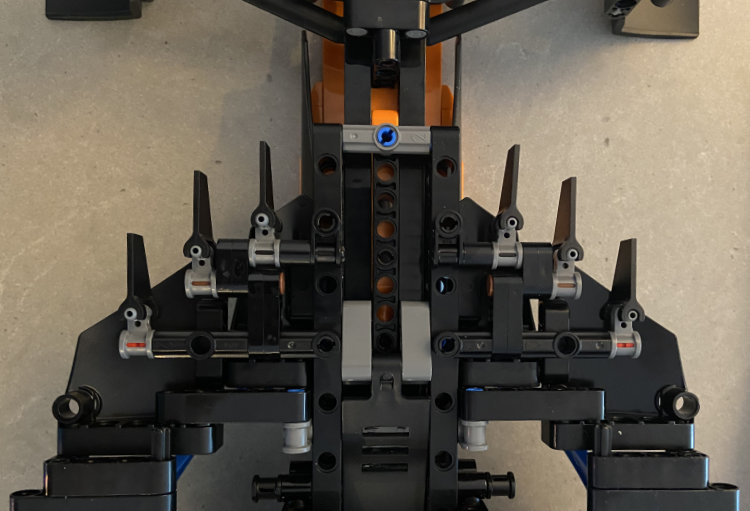
The front wing left me a little surprised when building but I must say it looks quite nice once finished. The new pieces, seen before above the front wheels, are used as the side of the wing. At the end of phase three the front wing is attached and the nose is completed.
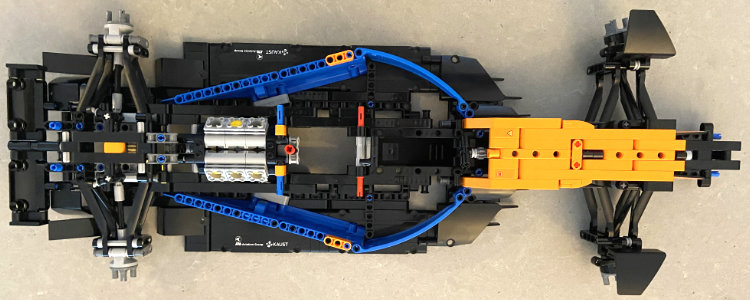
The front part is done, apart from the wheels. Let’s get going with the bodywork!
Phase 4
In phase 1-3 we used some orange but not a lot, mainly to build the nose. In this phase a lot of orange will come. We also add a lot of stickers. Some may like it, some may hate it, but the real-life car has a lot of branding so it’s no surprise to find the sheets of stickers in the box. After building the bodywork that goes above the fuel tank, we build a long winged shape that creates a large part of the rear bodywork. You build two mirrored pieces that are attached to either side of the car. Tied to that are the wings used to close up the core of the car. Once these pieces of bodywork are in place the opening is created to see the exposed cylinders. On the initial images I was not sure how I felt about this part. Seeing it in the build now I must say I don’t mind it.

The rear-wing is up next. In 2022 the rear wing has a big design change but the LEGO version has had some difficulty copying the shape. It is a very rounded shape so it is not an easy one. The new wing piece comes into play for a third time to create the sides of the rear wing. Also the smaller new blue pieces are used on the side of the wing.
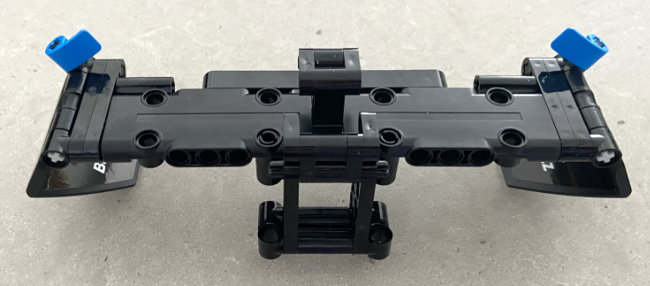
A big part of the F1 rear wing is the DRS, a system that opens up the wing once the car comes close to the car in front. The system creates extra pace and is essential to F1. On the old cars, this was a piece inside the wing opening up. For the 2022 models however, this is not clear. There will be some form of DRS, but it seems not inside the wing. Has LEGO given us a peek into the future here? On this set there is a moving part on the top of the wing (instead of inside the wing). Once the real-life testing starts, we can see it. But given the level of cooperation with McLaren, we are seeing the brand new on top of the wing incorporated into this set. The new wing plates that create the side of the rear-wing are really mimicking the shape on the new car very well.

The body work is completed with some bodywork at the front and a mirror on either side. Next we build the halo. In the Grosjean crash (and others) it has been a life saver! The halo is built to be part of the entire structure and feels strong.

The bodywork is completed with the blue top that sits on the top of the car, completed by the T-bar, showing black or yellow to see if it’s the teams first or second car. With this car showing black it means we’ve built Daniel Ricciardo’s MCL36.
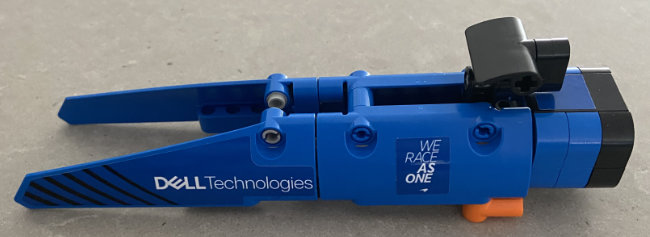
All that’s left is adding the tires. This year the cars will all be fitted with larger 18-inch rims… but with a hubcap to create the best airflow. That may be so, but they're not great to look at. A big thing is the tire size too. The set does not feature new tires but uses tires that have been seen before. The biggest negative on the tires though is that the front and rear tires are exactly the same, while the real F1 rear tire is quite a lot wider compared to the front tire.
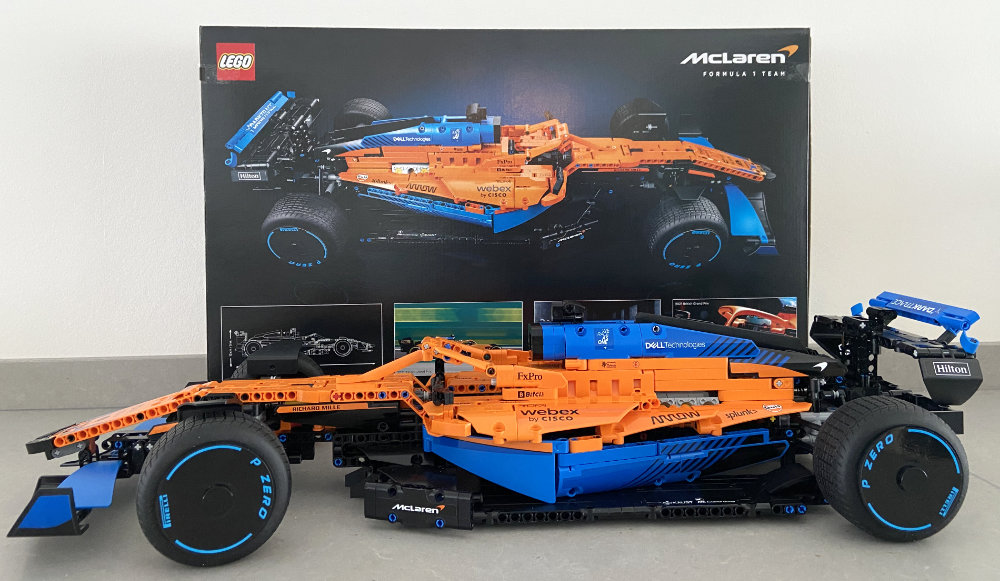
Final thoughts Now that set is finished the suspension feels quite flexible. The rear can ‘bottom out’ like you will see in real life creating sparks on the floor. The steering is not meant to be used for moving the car around, the angle is quite limited. The colors are vibrant and the dimensions are on point. The car really looks like the new 2022 F1 car and the color pallet gives you ample opportunity to see all the little design features. Although a detachable front-wing and a different size rear-tire would have been nice features, the set does not disappoint. All that is left is finding a nice place to put it. It is quite big, but I would not have wanted it any smaller.
33517